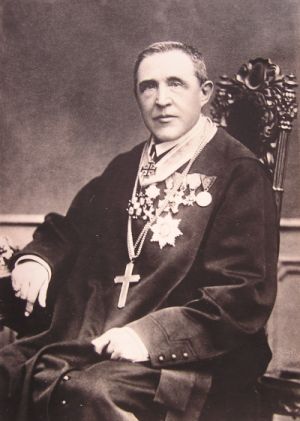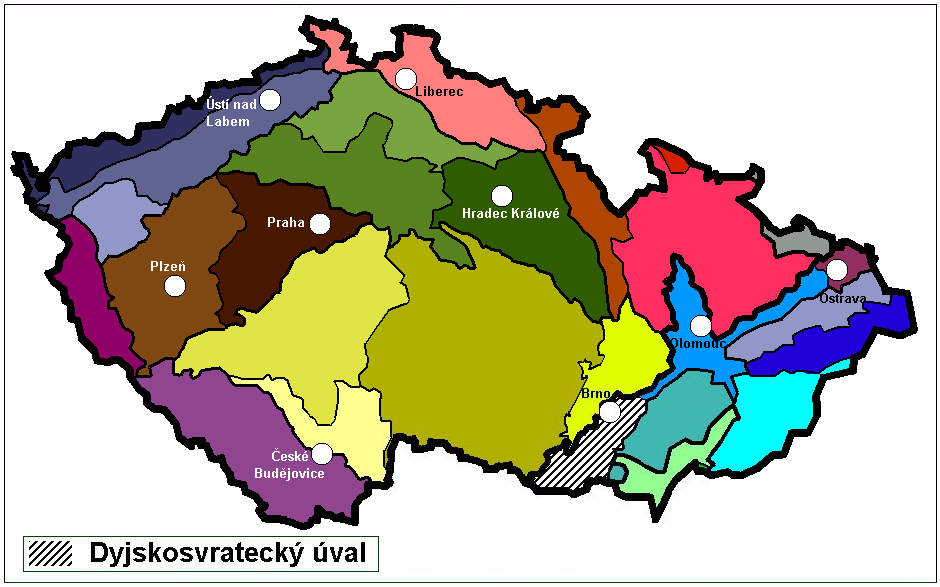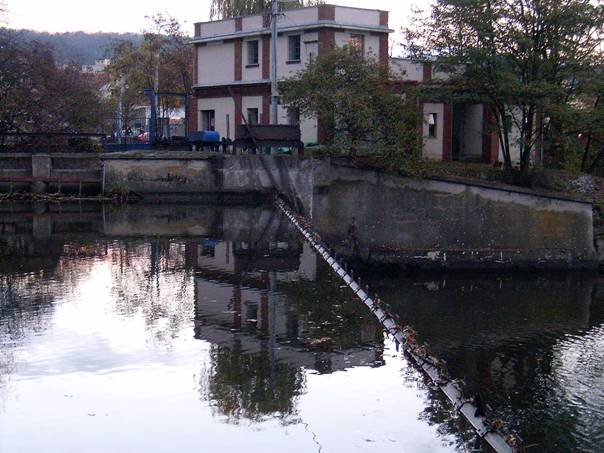|
Rajhrad
Rajhrad (german: Groß Raigern) is a town in Brno-Country District in the South Moravian Region of the Czech Republic. It has about 4,000 inhabitants. Geography Rajhrad is located about south of Brno. It lies in the Dyje–Svratka Valley. It is situated on the right bank of the Svratka River. History The first written mention of Rajhrad is from 1169. It was probably founded at the turn of 10th and 11th centuries and named after a nearby former gord. The Benedictine monastery was founded here in the mid-11th century. In 1234, Rajhrad was allowed to hold a market, and in 1330, it was called a market village. In 1339, it was first referred to as a market town. In 2000, Rajhrad became a town. Transport The D52 motorway runs next to the town. Sights The monastery is the main sight. It is one of the oldest and most valuable monasteries in Moravia. It includes the abbey Church of Saints Peter and Paul, which was built during the Baroque reconstruction of the monastery. It was desig ... [...More Info...] [...Related Items...] OR: [Wikipedia] [Google] [Baidu] |
Beda Dudík
Beda František Dudík (29 January 1815, Kojetín – 18 January 1890, Rajhrad) was a historian and Benedictines, Benedictine monk in the Rajhrad Monastery. Life After studying at the philosophical school at Brno he attended the University of Olomouc. In 1836 he entered the Benedictine Order and in 1840 was ordained priest at Rajhrad. Then until 1854 he taught first the classical languages and then history at the gymnasium of Brünn. In 1855 he became ''Privatdozent'' for historical research at the University of Vienna; in 1859 he was appointed historiographer of Moravia, and in 1865 was made a member of the Academy of Sciences of Vienna. For purposes of historical research he went in 1851 to Sweden, in 1852 to Rome, in 1870 to France, Belgium, and Holland, in 1874 to Russia, a country which he later repeatedly visited. Between the years 1853 and 1859 he established at Vienna the main historical library of the Teutonic Order. Works Dudík was a prolific writer; his works have a l ... [...More Info...] [...Related Items...] OR: [Wikipedia] [Google] [Baidu] |
Jan Santini Aichel
Jan Blažej Santini Aichel (3 February 1677 – 7 December 1723) was a Czech architect of Italian descent, whose major works represent the unique Baroque Gothic style - the special combination of the Baroque and Gothic styles. Biography He was born on the day of Saint Blaise as the oldest son to a respectable family of a Prague stonemasons Santini Aichel (his grandfather Antonio Aichel moved from Italy to Prague in the 1630s) and was baptized in the St. Vitus Cathedral as Johann Blasius Aichel. He was born with a physical disability – paralysis of a half of his body. This prevented him from a successful follow-up to his father's career. He only served his time of apprenticeship (as did his brother Franz), but he also studied painting from the imperial and royal painter Christian Schröder. Around 1696 he started to travel and gain experience. After his journey through Austria he arrived in Rome, Italy, where he had the possibility to meet with the work of a radical ... [...More Info...] [...Related Items...] OR: [Wikipedia] [Google] [Baidu] |
Dyje–Svratka Valley
The Dyje–Svratka Valley ( cs, Dyjsko-svratecký úval, german: Thaya-Schwarza Talsenke) is a geomorphological feature (a special type of vale) in South Moravian Region of the Czech Republic. History The Dyje–Svratka Valley has been a natural pass between the Vienna Basin (Carpathians) and the Vyškov Gate, the Upper Morava Valley, Moravian Gate and later, the North European Plain (Poland - Lower Silesia - Galicia) since ancient times. It served as an arm of several important trade routes from southern Europe to the Baltic Sea such as the Amber Road, as well as routes from Moravia to Upper Silesia and Lesser Poland. The Emperor Ferdinand Northern Railway from Břeclav to Brno traverses the Dyje–Svratka Valley. Geography The floodplains of several rivers end in the Dyje–Svratka Valley, including Svratka, Jihlava, Svitava, Thaya, Jevišovka and Litava. Many towns are located within it, including the southern districts of Brno, Slavkov u Brna, Židlochovice, Pohořel ... [...More Info...] [...Related Items...] OR: [Wikipedia] [Google] [Baidu] |
Josef Zelený
Josef Zelený (24 March 1824 in Rajhrad - 3 May 1886 in Brno) was a Moravian painter who was devoted to the formation of altarpieces, portraits and paintings of historical scenes, particular ones of a biblical nature. He studied in Brno, Prague, Vienna and Paris. See also *List of Czech painters This is a list of Czech painters. A * Miroslav Adámek *Mikoláš Aleš * Jiří Anderle *Jaroslav Augusta * Jan Autengruber B * Karel Balcar * Lojza Baránek * Vojtěch Bartoněk * Břetislav Bartoš * Viktor Barvitius * Jan Bauch * Aloi ... References 1824 births 1886 deaths People from Rajhrad Czech painters Czech male painters 19th-century painters of historical subjects {{CzechRepublic-painter-stub ... [...More Info...] [...Related Items...] OR: [Wikipedia] [Google] [Baidu] |
Brno-Country District
Brno-Country District ( cs, okres Brno-venkov) is one of seven districts ('' okres'') within South Moravian Region of the Czech Republic. Its administrative center is in the city of Brno. The most populated town of the district is Kuřim. The district is made by 187 municipalities, which is the highest number within all districts of the Czech Republic. List of municipalities Babice nad Svitavou - Babice u Rosic - Běleč - Bílovice nad Svitavou - Biskoupky - Blažovice - Blučina - Borač - Borovník - Branišovice - Branišovice - Bratčice - Brumov - Březina (former Blansko District) - Březina (former Tišnov District) - Bukovice - Čebín - Černvír - Česká - Chudčice - Čučice - Cvrčovice - ''Deblín'' - Dolní Kounice - Dolní Loučky - Domašov - ''Doubravník'' - Drahonín - Drásov - Hajany - Heroltice - Hlína - Hluboké Dvory - Holasice - Horní Loučky - Hostěnice - Hradčany - Hrušovany u Brna - Hvozdec - Ivaň - Ivančice - Javůrek - J ... [...More Info...] [...Related Items...] OR: [Wikipedia] [Google] [Baidu] |
D52 Motorway (Czech Republic)
D52 highway ( cs, Dálnice D52), formerly Expressway R52 ( cs, Rychlostní silnice R52) is a highway in the South Moravian Region of the Czech Republic, currently leading from Modřice, about south of Brno, to Pohořelice, parallel to the Highway D2. It forms part of the European road E461. Sections of the expressway: From Pohořelice the ordinary road No. 52 runs further southwards to the border with Austria at Mikulov. According to a 2009 treaty between the Czech Republic and Austria, it is to be completed as an expressway and continuous connection between Brno and the Austrian A5 North Autobahn at Drasenhofen, leading to Vienna. Within the agglomeration of Brno plans for a new route intend to relocate the R52 running from the Rajhrad junction northwestwards bypassing the city centre to reach the Highway D1 and the Expressway R43 at Troubsko. Parts of the expressway were built on sections of the former ''Strecke 88'' Autobahn constructed between 1939 and 1942 during th ... [...More Info...] [...Related Items...] OR: [Wikipedia] [Google] [Baidu] |
Gord (archaeology)
A gord is a medieval Slavonic fortified settlement, usually built on strategic sites such as hilltops, riverbanks, lake islets or peninsulas between the 6th and 12th centuries CE in Central and Eastern Europe. The typical gord usually consisted of a group of wooden houses surrounded by a wall made of earth and wood, and a palisade running along the top of the bulwark. Etymology The term ultimately descends from the reconstructed Proto-Indo-European root '' ǵʰortós'', enclosure. The Proto-Slavic word ''*gordъ'' later differentiated into grad ( Cyrillic: град), gorod (Cyrillic: город), gród in Polish, gard in Kashubian, etc. It is the root of various words in modern Slavic languages pertaining to fences and fenced-in areas (Belarusian гарадзіць, Ukrainian horodyty, Czech ohradit, Russian ogradit, Serbo-Croatian ograditi, and Polish ogradzać, grodzić, to fence off). It also has evolved into words for a garden in certain languages. Additionally, ... [...More Info...] [...Related Items...] OR: [Wikipedia] [Google] [Baidu] |
Moravia
Moravia ( , also , ; cs, Morava ; german: link=yes, Mähren ; pl, Morawy ; szl, Morawa; la, Moravia) is a historical region in the east of the Czech Republic and one of three historical Czech lands, with Bohemia and Czech Silesia. The medieval and early modern Margraviate of Moravia was a crown land of the Lands of the Bohemian Crown from 1348 to 1918, an imperial state of the Holy Roman Empire from 1004 to 1806, a crown land of the Austrian Empire from 1804 to 1867, and a part of Austria-Hungary from 1867 to 1918. Moravia was one of the five lands of Czechoslovakia founded in 1918. In 1928 it was merged with Czech Silesia, and then dissolved in 1949 during the abolition of the land system following the communist coup d'état. Its area of 22,623.41 km2 is home to more than 3 million people. The people are historically named Moravians, a subgroup of Czechs, the other group being called Bohemians. Moravia also had been home of a large German-speaking populati ... [...More Info...] [...Related Items...] OR: [Wikipedia] [Google] [Baidu] |
Městys
Městys (or, unofficially or obsolete, městečko (literally "small town")), translated as "market town", is a status conferred on certain municipalities in the Czech Republic, lying in terms of size and importance higher than that of simple ''obec'' (municipality), but lower than that of ''město'' (city, town). Historically a ''městys'' was a locality which had the right to stage livestock markets (and some other "extraordinary" and annual markets), and it is therefore translated as "market town". The term went out of official use in Czechoslovakia in 1954, but was reintroduced in the Czech Republic in 2006. As of September 2020, there are 228 municipalities on which the status of ''městys'' has been re-admitted. In all cases, these are municipalities that have requested the return of their former title. This title has not been newly awarded to any municipality that would not have it in the past, the law does not even set any specific criteria for it, only procedural competenc ... [...More Info...] [...Related Items...] OR: [Wikipedia] [Google] [Baidu] |
Benedictines
, image = Medalla San Benito.PNG , caption = Design on the obverse side of the Saint Benedict Medal , abbreviation = OSB , formation = , motto = (English: 'Pray and Work') , founder = Benedict of Nursia , founding_location = Subiaco Abbey , type = Catholic religious order , headquarters = Sant'Anselmo all'Aventino , num_members = 6,802 (3,419 priests) as of 2020 , leader_title = Abbot Primate , leader_name = Gregory Polan, OSB , main_organ = Benedictine Confederation , parent_organization = Catholic Church , website = The Benedictines, officially the Order of Saint Benedict ( la, Ordo Sancti Benedicti, abbreviated as OSB), are a monastic religious order of the Catholic Church following the Rule of Saint Benedict. They are also sometimes called the Black Monks, in reference to the colour of their religious habits. They ... [...More Info...] [...Related Items...] OR: [Wikipedia] [Google] [Baidu] |
Obec
Obec (plural: ''obce'') is the Czech language, Czech and Slovak language, Slovak word for a municipality (in the Czech Republic, in Slovakia and abroad). The literal meaning of the word is "Intentional community, commune" or "community". It is the smallest administrative unit that is governed by elected representatives. Cities and towns are also municipalities. Definition Legal definition (according to the Czech code of law with similar definition in the Slovak code of law) is: ''"The municipality is a basic territorial self-governing community of citizens; it forms a territorial unit, which is defined by the boundary of the municipality."'' Every municipality is composed of one or more cadastre, cadastral areas. Every municipality is composed of one or more administrative parts, usually called town parts or villages. A municipality can have its own flag and coat of arms. Czech Republic Almost whole area of the republic is divided into municipalities, with the only exception be ... [...More Info...] [...Related Items...] OR: [Wikipedia] [Google] [Baidu] |
Svratka (river)
The Svratka (), formerly ''Švarcava'' (german: Schwarzach) is a river in the South Moravian Region of the Czech Republic. It is long, and its basin area is . It rises in the Bohemian-Moravian Highlands, converges with the Svitava in Brno, and flows into the Dyje (''Thaya'') a near Mikulov. The river is known in the local Moravian dialect as the ''Švarcava'' (from the German German(s) may refer to: * Germany (of or related to) ** Germania (historical use) * Germans, citizens of Germany, people of German ancestry, or native speakers of the German language ** For citizens of Germany, see also German nationality law **Ge ... name of the river ''Schwarzach''). References Rivers of the Vysočina Region Rivers of the South Moravian Region Břeclav District Žďár nad Sázavou District {{CzechRepublic-river-stub ... [...More Info...] [...Related Items...] OR: [Wikipedia] [Google] [Baidu] |





